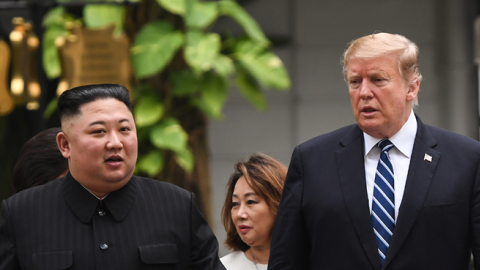The verdict is in on Trump’s refusal to strike a deal with North Korea’s Kim Jong-un at their summit in Hanoi last week — or more precisely two verdicts are in. The media and the usual Trump critics have pronounced the summit a disaster: “How the Trump-Kim Summit Failed: Big Threats, Big Egos, Bad Bets,” is how the New York Times portrayed it. The other verdict comes from Trump admirers who have compared Trump’s performance with Ronald Reagan’s at Reykjavík in 1986, when Reagan walked away from a deal with Soviet leader Mikhail Gorbachev regarding nuclear weapons — a walkout that most historians now concede represented a watershed in U.S.–Soviet relations and led ultimately to the end of the Cold War.
As it happens, the admirers are more correct than the critics. But it’s important to understand why the comparison with Reagan is not farfetched — and why in this case President Trump has a much stronger hand to play with the North Koreans than Reagan had with Gorbachev.
A little history is in order. Ronald Reagan and Mikhail Gorbachev held their first-ever summit in Geneva the previous year, and continued their discussion regarding reducing their respective nuclear arsenals in Reykjavik in October 1986. In the end, Reagan walked away from a final deal that would have spelled the end of all U.S. and Soviet ballistic missiles and even the elimination of all nuclear weapons, because Gorbachev wanted constraints on the Strategic Defense Initiative, which Reagan had announced three years earlier.
Reagan walked away because he sensed that SDI was his ace in the hole in dealing with the Soviet Union. Denounced and derided as “Star Wars” by critics (the same critics who would lambaste Reagan for walking out at Reykjavik), the Strategic Defense Initiative offered a long-term insurance policy that the Soviet Union could never threaten the U.S. with nuclear-missile attack.
Today, whether he knows it or not, Trump has his own ace, and his own insurance policy, for dealing with North Korea. It’s a game-changing ballistic-missile technology that deploys remotely piloted drones to target missiles in flight while the missile booster engines are still firing. During this early “boost phase,” the intense heat of the boosters makes missiles easier to detect — and their slower speed makes it easier to intercept them with a high-speed kinetic missile.
The system is simple, and unlike Reagan’s Strategic Defense Initiative, involves the use of already-available technologies. High-altitude drones would circle above the Sea of Japan at roughly 45,000 feet for shifts of up to 20 hours. Detection systems the Air Force already uses on surveillance drones would be able to pick up North Korean missiles soon after launch. Once the drones’ operators determine that the missile is on a threatening course, a high-speed missile interceptor launched from the drones would destroy the ICBMs, ensuring that any debris would fall onto or near North Korean territory.
This program can be realized in less than two years. I have discussed it in this space in the past. Since then, Congress has authorized money to be used to develop and test the concept. The Air Force has expressed interest in investing in it, in part through the use of manned as well as unmanned aircraft. The Missile Defense Agency has admitted it’s feasible. All that’s needed is the political will to see it through.
This is Trump’s other ace. As in 1986, we have a president who understands that protecting the American people must be his number-one priority, not reaching international agreements that win the applause of the New York Times and the Council on Foreign Relations. He also has a new secretary of defense, Patrick Shanahan, who understands how technology can reshape the international balance of power as well as the battlefield; and a national-security adviser and a secretary of state who both understand that dealing with a totalitarian rogue nation such as North Korea demands both carrots and sticks. And a boost-phase intercept program that can snatch away, for good, Kim’s ability to threaten his neighbors and the U.S. with ballistic missiles is a pretty impressive stick.
The New York Times dismissed Trump’s summit as a gamble. But it’s not a gamble if you know you have the winning card all along.

















